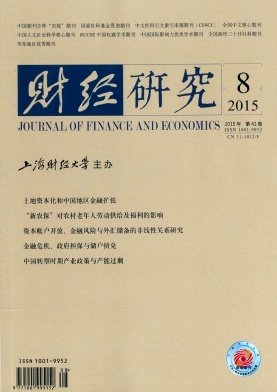资本账户开放、金融风险与外汇储备的非线性关系研究
财经研究 2015 年 第 41 卷第 08 期, 页码:
摘要
参考文献
摘要
近年来,我国稳步推进资本账户开放,同时美元利率、汇率持续走强可能引发国际资本外流。那么,在我国外汇储备规模增速放缓且总量存在下滑风险的背景下,能否应对由此引发的金融动荡是一个十分值得研究的重要问题。鉴于此,文章构建了包括重商主义动机和预防性动机的非线性模型,采用面板平滑转换回归(PSTR)模型和全球36个国家(地区)的数据,考察了资本账户开放情况下,外债风险和流动性风险等金融风险对上述两类外汇储备动机的影响效应,并结合金融风险门槛变量分析了两类动机估计系数的演变过程。研究发现,由于金融风险增大使出口增长放缓、贸易条件恶化,重商主义动机中出口增长率和贸易条件对外汇储备的贡献逐渐减弱;而预防性动机中资本账户开放指数和外商直接投资净流入波动对外汇储备的正向效应则逐渐增强。其原因主要在于,国内风险陡增将导致投资于本国的资本面临损失和贬值风险,而此时如果开放资本账户,则将加剧资本外逃和资本波动对经济增长的负面冲击,出于预防性动机需求,央行会主动增加外汇储备进行应对。此外,文章还发现大部分国家增加外汇储备更多的是出于预防性动机,只有少数国家兼顾重商主义动机和预防性动机。最后,文章就现阶段我国开放资本账户与管控金融风险提出了若干建议。
关键词
[1]陈创练,杨子晖.“泰勒规则”、资本流动与汇率波动研究[J].金融研究,2012,(11):60-73.
[2]李巍.资本账户开放、金融发展和经济金融不稳定的国际经验分析[J].世界经济,2008,(3):34-43.
[3]Aizenman J. Hoarding international reserves versus a Pigovian taxcumsubsidy scheme: Reflections on the deleveraging crisis of 2008-2009, and a cost benefit analysis[J]. Journal of Economic Dynamics and Control, 2011, 35(9): 1502-1513.
[4]Aizenman J. Large hoarding of international reserves and the emerging global economic architecture[J]. Manchester School, 2007, 76(5): 487-503.
[5]Caballero R, Panageas S. A quantitative model of sudden stops and external liquidity management[R]. NBER Working Paper No. 11293, 2005.
[6]Delatte AL, Fouquau J. The determinants of international reserves in the emerging countries: A nonlinear approach[R]. MPRA Paper No. 16311, 2009.
[7]Cheng G. A growth perspective on foreign reserve accumulation[J]. Macroeconomic Dynamics, 2014, 1(1): 1-22.
[8]Dooley M, FolkertsLandau D, Garber P. An essay on the revived bretton woods system[R]. NBER Working Paper No. 9971, 2003.
[9]Eichengreen B. Capital account liberalization: What do the crosscountry studies tell us?[J]. World Bank Economic Review, 2001, 15(3): 341-365.
[10]Faust J, Rogers J H,Swanson E,et al. Identifying the effects of monetary policy shocks on exchange rates using high frequency data[J]. Journal of the European Economic Association, 2003, 1(5):1031-1057.
[11]IMF. Three current policy issues in developing countries[J]. World Economic Outlook: Building Institutions, 2003, 9: 65-111.
[12]Jeanne O. International reserves in emerging market countries: Too much of a good thing?[J]. Brooking Papers on Economic Activity, 2007,2007(1):1-55.
[13]Jeanne O, Ranciere R. The optimal level of international reserves for emerging market countries: A new formula and some applications[J]. Economic Journal, 2011, 121(555): 905-930.
[14]Mendoza R. Was the Asian crisis a wakeup call? Foreign reserves as selfprotection[J]. Journal of Asian Economics, 2010, 21(1): 1-19.
[15]Obstfeld M, Shambaugh J C, Taylor A M. Financial stability, the trilemma, and international reserves[J]. American Economic Journal: Macroeconomics,2010,2(2):57-94.
[16]Radelet S, Sachs J. The onset of the East Asian financial crisis[R]. NBER Working Paper No. 6680, 1998.
[17]RuizArranz M, Zavadjil M. Are emerging Asia’s reserves really too high?[R]. International Monetary Fund Working Paper No.08/192, 2008.
[18]Scholl A, Uhlig H. New evidence on the puzzles: Results from agnostic identification on monetary policy and exchange rates[J]. Journal of International Economics, 2008, 76(1): 1-13.
[19]Sun L. Measuring timevarying capital mobility in East Asia[J]. China Economic Review, 2004, 15(3): 281-291.
[20]Taylor M P. The economics of exchange rates[J]. Journal of Economic Literature, 1995, 33(1): 13-47.
[2]李巍.资本账户开放、金融发展和经济金融不稳定的国际经验分析[J].世界经济,2008,(3):34-43.
[3]Aizenman J. Hoarding international reserves versus a Pigovian taxcumsubsidy scheme: Reflections on the deleveraging crisis of 2008-2009, and a cost benefit analysis[J]. Journal of Economic Dynamics and Control, 2011, 35(9): 1502-1513.
[4]Aizenman J. Large hoarding of international reserves and the emerging global economic architecture[J]. Manchester School, 2007, 76(5): 487-503.
[5]Caballero R, Panageas S. A quantitative model of sudden stops and external liquidity management[R]. NBER Working Paper No. 11293, 2005.
[6]Delatte AL, Fouquau J. The determinants of international reserves in the emerging countries: A nonlinear approach[R]. MPRA Paper No. 16311, 2009.
[7]Cheng G. A growth perspective on foreign reserve accumulation[J]. Macroeconomic Dynamics, 2014, 1(1): 1-22.
[8]Dooley M, FolkertsLandau D, Garber P. An essay on the revived bretton woods system[R]. NBER Working Paper No. 9971, 2003.
[9]Eichengreen B. Capital account liberalization: What do the crosscountry studies tell us?[J]. World Bank Economic Review, 2001, 15(3): 341-365.
[10]Faust J, Rogers J H,Swanson E,et al. Identifying the effects of monetary policy shocks on exchange rates using high frequency data[J]. Journal of the European Economic Association, 2003, 1(5):1031-1057.
[11]IMF. Three current policy issues in developing countries[J]. World Economic Outlook: Building Institutions, 2003, 9: 65-111.
[12]Jeanne O. International reserves in emerging market countries: Too much of a good thing?[J]. Brooking Papers on Economic Activity, 2007,2007(1):1-55.
[13]Jeanne O, Ranciere R. The optimal level of international reserves for emerging market countries: A new formula and some applications[J]. Economic Journal, 2011, 121(555): 905-930.
[14]Mendoza R. Was the Asian crisis a wakeup call? Foreign reserves as selfprotection[J]. Journal of Asian Economics, 2010, 21(1): 1-19.
[15]Obstfeld M, Shambaugh J C, Taylor A M. Financial stability, the trilemma, and international reserves[J]. American Economic Journal: Macroeconomics,2010,2(2):57-94.
[16]Radelet S, Sachs J. The onset of the East Asian financial crisis[R]. NBER Working Paper No. 6680, 1998.
[17]RuizArranz M, Zavadjil M. Are emerging Asia’s reserves really too high?[R]. International Monetary Fund Working Paper No.08/192, 2008.
[18]Scholl A, Uhlig H. New evidence on the puzzles: Results from agnostic identification on monetary policy and exchange rates[J]. Journal of International Economics, 2008, 76(1): 1-13.
[19]Sun L. Measuring timevarying capital mobility in East Asia[J]. China Economic Review, 2004, 15(3): 281-291.
[20]Taylor M P. The economics of exchange rates[J]. Journal of Economic Literature, 1995, 33(1): 13-47.
引用本文
陈创练, 黄楚光, 陈创波. 资本账户开放、金融风险与外汇储备的非线性关系研究[J]. 财经研究, 2015, 41(8): 0.
导出参考文献,格式为:





 9414
9414  4386
4386

